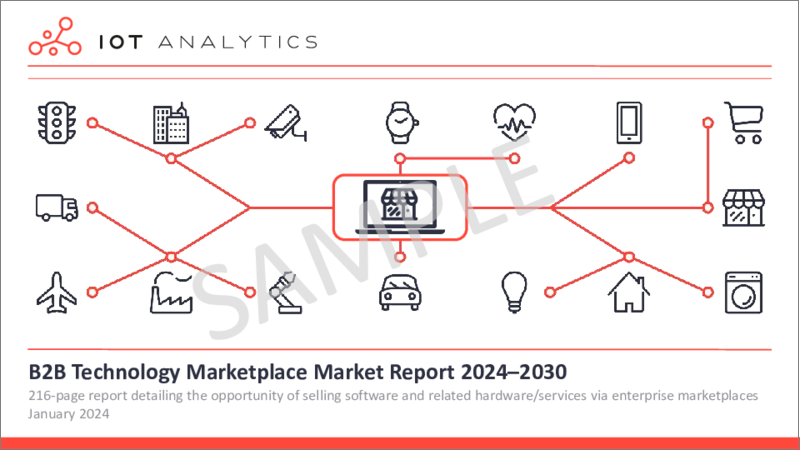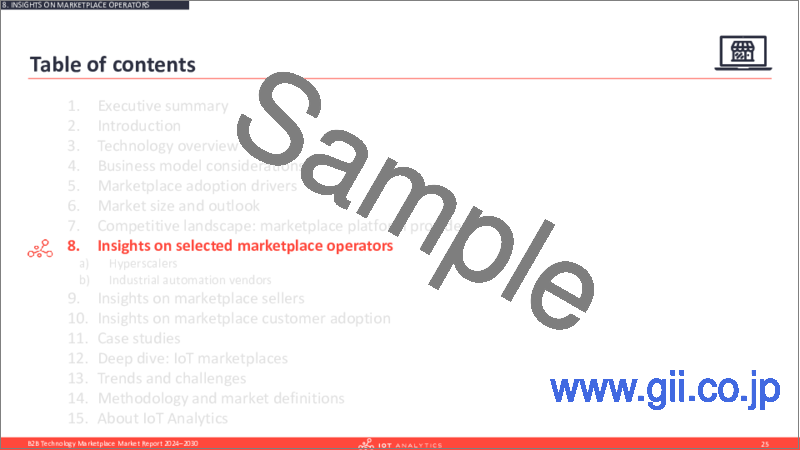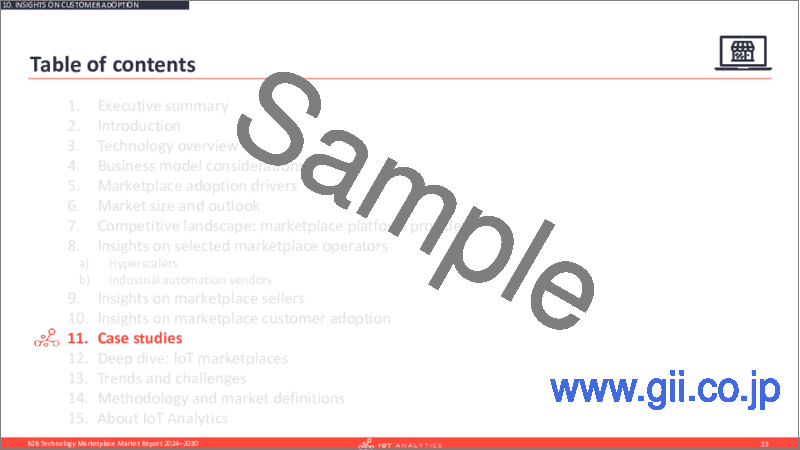|
|
市場調査レポート
商品コード
1410438
B2B技術マーケットプレイス:市場分析 (2024年~2030年)B2B Technology Marketplaces Market Report 2024-2030 |
||||||
|
|||||||
| B2B技術マーケットプレイス:市場分析 (2024年~2030年) |
|
出版日: 2024年01月18日
発行: IoT Analytics GmbH
ページ情報: 英文 216 Page PDF
納期: 即日から翌営業日
|
全表示
- 概要
- 目次
当レポートでは、企業向けマーケットプレイスを通じたソフトウェアおよびハードウェア/サービスの販売機会について分析すると共に、100件のマーケットプレイスと50社のマーケットプレイス・プラットフォームプロバイダーの一覧を掲載しています。
サンプル
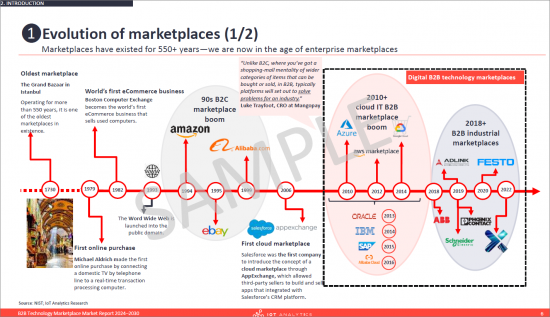
当レポートは、IoTソフトウェアとプラットフォームに関するIoT Analyticsの継続的調査の一部です。当レポートに掲載されている情報は、2023年5月から12月にかけて行われた複数の調査、2次調査、定性調査 (クラウドの専門家、販売者、エンドユーザーへのインタビュー) の結果に基づいています。当レポートには、B2B技術マーケットプレイスの定義、マーケットプレイス・プラットフォームのプロバイダー、採用の促進要因、競合情勢、主要な傾向と動静、ケーススタディが含まれています。
当レポートの主な目的は、市場の定義・規模計測・分析を通じて、読者がB2B技術マーケットプレイスの現状への理解を深めることにあります。
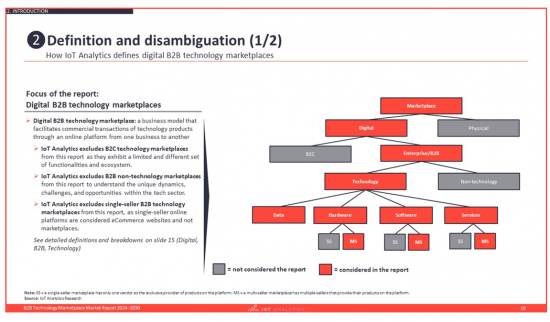
デジタルB2B技術マーケットプレイスとは?
デジタルB2Bテクノロジー・マーケットプレイスとは、技術製品の企業間商取引を可能にするオンラインプラットフォームです。技術製品に特化しているため、他のB2Bマーケットプレイスとは一線を画しています。
デジタルB2B技術マーケットプレイスは、現代のハイテク業界の重要な構成要素です。企業が技術製品の商取引を行うためのプラットフォームを提供し、この分野の成長とイノベーションに貢献しています。その影響と可能性を十分に理解するためには、さらなる調査と分析が必要です。
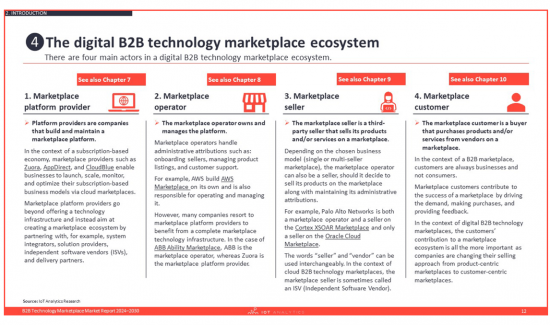
B2Bテクノロジー・マーケットプレイスへの支出
ソフトウェアが、最も急成長しているカテゴリーとして浮上しています。この急成長は、クラウドとSaaS (Software as a Service) ソリューションの普及によるところが大きいです。
ハードウェアは、2022年のB2B技術マーケットプレイスにおける支出額の半分弱を占めるもの、緩やかな成長を遂げています。これは、初期費用が高く、製品ライフサイクルが長いといった要因によるものです。
最後に、サービスの成長率は緩やかながら安定しています。この動向は、保守やサポートを含む「as-a-service」モデルの台頭が影響しています。
当レポートの分析内容
- どの技術が、B2B技術マーケットプレイスの構築に使われているか?
- 代表的なB2Bマーケットプレイスはどれか?その利用事例は?
- どのような新しいビジネスモデルが、B2B技術マーケットプレイスで許可されているのか?
- 現在、B2B技術マーケットプレイスで費やされている金額はどれだけか?2030年にはどうなっているのか?
- クラウド・マーケットプレイスはどのように差別化されているのか?
- 産業オートメーションの販売者は、自社とそのマーケットプレイスをどのように位置づけているのか?
- 企業が自らB2B技術マーケットプレイスを開設・販売することで、どのようなメリットを得ているのか?
- B2B技術マーケットプレイスの動向と課題は何か?
- 主要なB2Bマーケットプレイス・プラットフォーム・プロバイダーの市場シェアはどれだけか?
言及されている企業
当レポートの分析対象企業の一部
|
|
|
目次
第1章 エグゼクティブサマリー
第2章 イントロダクション
- マーケットプレイスの進化
- 定義と曖昧さ回避
- 当レポートで取り上げる、デジタルB2Bマーケットプレイスの運営者の種類
- デジタルB2B技術マーケットプレイスのエコシステム
- デジタルB2B技術マーケットプレイスのユーザーインターフェイス機能
- デジタルB2B技術マーケットプレイスの内訳
第3章 技術の概要
- マーケットプレイスのアーキテクチャ要素:フロントエンドとバックエンド
- デジタルB2B技術マーケットプレイスのアーキテクチャ
- a. 顧客の要望への対応
- b. 販売者の統合
- c. アーキテクチャの見取り図
- アーキテクチャの事例
第4章 ビジネスモデルの考慮事項
- 成功するデジタルB2B技術マーケットプレイス・ビジネスの構築:重要な考慮事項
- 顧客中心主義の重視
- デジタルB2B技術マーケットプレイス製品の定義
- 既存の再販業者の関与
- 適切な販売チャネル戦略の策定
- 販売者のB2B技術マーケットプレイス戦略を理解し、影響を与える
第5章 マーケットプレイス導入の促進要因
- マーケットプレイス導入の一般的な促進要因
- マーケットプレイス導入の促進要因:マーケットプレイス運営者の場合
- マーケットプレイス導入の促進要因:マーケットプレイス販売者の場合
第6章 市場規模と展望
- 概要:B2Bマーケットプレイスの市場を観察する2つの方法
- B2Bマーケットプレイスの支出額 (2020年~2030年)
- B2B技術マーケットプレイスの支出額 (2020年~2030年)
- B2B技術マーケットプレイス・ソフトウェアの支出額 (2020年~2030年)
- B2B技術マーケットプレイス・プラットフォームの支出額 (2020年~2030年)
- 主要な採用の観点
第7章 競合情勢:マーケットプレイスプラットフォームのプロバイダー
- その他のB2Bマーケットプレイス/eコマース・プラットフォーム
- B2Bマーケットプレイス・プラットフォーム・プロバイダーの市場シェア
第8章 選択されたマーケットプレイス運営者に関する洞察
- ハイパースケーラー
- 産業オートメーション・ベンダー
第9章 マーケットプレイスの販売者に関する洞察
- 技術販売者にとっての、企業向けマーケットプレイスで販売する主な利点
- 企業向けマーケットプレイスに出品する際の、販売者の主な目標:企業規模別
- 企業向けマーケットプレイスに出品する際の、販売者のメリットとデメリット
第10章 顧客によるマーケットプレイスの採用に関する洞察
- B2B調達におけるマーケットプレイスの利用
- 調達チャネル:マーケットプレイスの収益シェア
- ソフトウェアライセンスの予算制限
- いつ、企業はマーケットプレイスで調達するのか?
- a. 調達プロセスが単純な場合
- b. 信頼できるマーケットプレイス・ガバナンスがある場合
- c. 無料トライアルを実行できる場合
第11章 ケーススタディ
第12章 詳細分析:IoTマーケットプレイス
- IoTソリューションにおけるB2Bマーケットプレイスの役割
- AWSとAzureが、マーケットプレイスでのフットプリントを拡大
- IoTプラットフォーム内で共通のIoTアプリケーションマーケットプレイス
- エッジマーケットプレイスの件数の増加
- マーケットプレイスは、クラウドからエッジまでのアーキテクチャで重要な役割を果たす
- IoTに焦点を当てたマーケットプレイス
第13章 動向と課題
第14章 分析手法と市場の定義
第15章 IoT Analyticsについて
This publication analyses the opportunity of selling software and related hardware / services via enterprise marketplaces, including, a 216-page market report, list of 100 marketplaces and 50 marketplace platform providers.
SAMPLE VIEW

The “B2B Technology Marketplaces Market Report 2024-2030” is part of IoT Analytics' ongoing coverage of IoT software and platforms. The information presented in this report is based on the results of multiple surveys, secondary research, and qualitative research, i.e., interviews with cloud experts, sellers, and end users between May and December 2023. The document includes definitions for the B2B technology marketplace, marketplace platform providers, adoption drivers, competitive landscapes, key trends and developments, and case studies.
The main purpose of this document is to help our readers understand the current landscape of B2B technology marketplaces by defining, sizing, and analyzing the market.

What are digital B2B technology marketplaces?
Digital B2B Technology Marketplaces are online platforms that enable commercial transactions of technology products between businesses. These platforms are distinct from other types of B2B marketplaces due to their specific focus on technology products.
This analysis does not include B2C technology marketplaces. The functionalities and ecosystems of B2C marketplaces differ significantly from those of B2B marketplaces, as they are designed to cater to individual consumers rather than businesses.
Similarly, B2B non-technology marketplaces are not part of this discussion. The aim is to understand the unique dynamics, challenges, and opportunities within the technology sector.
IoT Analytics excludes single-seller B2B technology marketplaces from this report, as single-seller online platforms are considered eCommerce websites and not marketplaces.
Digital B2B Technology Marketplaces are a significant component of the modern tech sector. They provide a platform for businesses to engage in commercial transactions of technology products, contributing to the growth and innovation in the sector. Further research and analysis are required to fully understand their impact and potential.

There are four main actors in a digital B2B technology marketplace ecosystem
1. Marketplace platform provider
- Platform providers are companies that build and maintain a marketplace platform.
2. Marketplace operator
- The marketplace operator owns and manages the platform.
3. Marketplace seller
- The marketplace seller is a third-party seller that sells its products and/or services on a marketplace.
4. Marketplace customer
- The marketplace customer is a buyer that purchases products and/or services from vendors on a marketplace.
B2B technology marketplace spending
Software has emerged as the fastest-growing category. This surge is largely attributed to the widespread adoption of cloud and Software as a Service (SaaS) solutions.
Hardware, while accounting for less than half of the spending in B2B technology marketplaces in 2022, has experienced moderate growth. This is due to factors such as high upfront costs and longer product life cycles.
Lastly, Services have seen a steady, albeit slower, growth. This trend is influenced by the rise of "as-a-servic" models, including maintenance and support.
Questions answered:
- Which technologies are used for building B2B technology marketplaces?
- Which are the leading B2B marketplaces and some of their case studies?
- Which new business models do B2B technology marketplaces allow?
- How much is spent on B2B technology marketplaces today, and what will it look like in 2030?
- How do cloud marketplaces differentiate from each other?
- How do industrial automation sellers position themselves and their marketplaces?
- What benefits are companies seeing from opening their own B2B technology marketplace and from selling on a B2B technology marketplace?
- What are the trends and challenges when it comes to B2B technology marketplaces?
- How much market share do leading B2B marketplace platform providers have?
Companies mentioned:
A selection of companies mentioned in the report.
|
|
|
Table of Contents
1. Executive Summary
2. Introduction
- 2.1. Evolution of marketplaces
- 2.2. Definition and disambiguation
- 2.3. Types of digital B2B marketplace operators covered in this report
- 2.4. Digital B2B technology marketplace ecosystem
- 2.5. User interface features of digital B2B technology marketplaces
- 2.6. Digital B2B technology marketplace breakdown
3. Technology Overview
- 3.1. Marketplace architecture elements: frontend and backend
- 3.2. Digital B2B technology marketplace architecture
- a. Handling customer request
- b. Integrating sellers
- c. Architecture blueprint
- 3.3. Architecture examples
4. Business model considerations
- 4.1. Building a successful digital B2B technology marketplace business: key considerations
- 4.2. Focusing on customer centricity
- 4.3. Defining digital B2B technology marketplace offerings
- 4.4. Involving existing resellers
- 4.5. Developing suitable sales channel strategies
- 4.6. Understanding and influencing seller B2B technology marketplace strategies
5. Marketplace adoption drivers
- 5.1. General marketplace adoption driver
- 5.2. Marketplace adoption drivers for marketplace operators
- 5.3. Marketplace adoption drivers for marketplace sellers
6. Market size and outlook
- 6.1. Overview: Two ways to look at the market for B2B marketplaces
- 6.2. B2B marketplace spending 2020-2030
- 6.3. B2B technology marketplace spending 2020-2030
- 6.4. B2B technology marketplace software spending 2020-2030
- 6.5. B2B technology marketplace platform spending 2020-2030
- 6.6. Selected adoption viewpoints
7. Competitive landscape: Marketplace platform providers
- 7.9. Other B2B marketplace and eCommerce platforms
- 7.10. Market share of B2B marketplace platform providers
8. Insights on selected marketplace operators
- 8.1. Hyperscalers
- 8.2. Industrial automation vendors
9. Insights on marketplace sellers
- 9.1. Key benefits of selling on enterprise marketplaces for technology sellers
- 9.2. Sellers' main goals when listing on an enterprise marketplace based on company size
- 9.3. Sellers' pros and cons when listing on enterprise marketplaces
10. Insights on marketplace customer adoption
- 10.1. Usage of marketplace in B2B procurement
- 10.2. Procurement channels - Share of marketplace revenue
- 10.3. Budget limits for software licenses
- 10.4. When do companies procure on a marketplace?
- a. When the procurement process is simple
- b. When there is credible marketplace governance
- c. When they have the ability to do a free trial
11. Case studies
12. Deep-dive: IoT Marketplaces
- 12.1. The role of B2B marketplaces for IoT solutions
- 12.2. AWS and Azure increase their footprint with their marketplaces
- 12.3. IoT application marketplaces common within IoT platforms
- 12.4. An increasing number of edge marketplaces
- 12.5. Marketplaces play a key role in cloud-to-edge architectures
- 12.6. IoT-focused marketplaces
